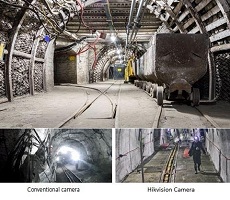
As unique operating environments mines endure highly specific health and safety challenges, and these were just some of the issues facing Jiangzhuang Coal Mine in the Shangdong Province of China. The top priority for the mine’s management team is worker safety, and working practices and production are monitored 24 hours a day to minimize accident risks. he Jiangzhuang Coal Mine covers an underground area of 43 square kilometers, and produces more than 1.8 million tons of coal each year.
Kong Qingwei, Director of the Jiangzhuang Coal Mine Dispatch Office, says, “We need to respond immediately to unsafe situations in the mine, whether they are caused by environmental factors, poorly performing machines, or employees not following authorised work procedures.”
Underground mining operations typically experience low-visibility conditions and light pollution from flashlights, vehicle lights and reflective strips on equipment and clothing, making traditional surveillance and safety monitoring difficult. And, although the mine invests heavily in safety training and equipment for workers, its ageing surveillance system made health and safety monitoring difficult in key areas of the mine.
To address these challenges, Jiangzhuang Coal Mine has implemented an intelligent video surveillance and control system from Hikvision, which supports effective video imaging, even in low-light conditions, or where light pollution is created by lights or reflective strips. This quality and clarity of imaging helps to ensure that hidden risks can be identified more quickly and easily, allowing the safety team to respond more quickly and to protect workers in all areas of the mine.
In addition to the improved imaging capabilities, the Hikvision cameras incorporate deep learning technologies to identify and respond to health and safety risks in the mine automatically, and in real time. Specifically, the cameras can identify when employees deviate from approved work procedures and send alerts to the safety team to ensure staff can be deployed before accidents occur.
For example, it is prohibited for workers to come too close to winches when they are working due to safety risks, but this is hard to monitor with traditional video cameras. “The new Hikvision system increases worker safety by monitoring the areas around winches and other equipment, and by sending alerts if employees get too close,” says Kong Qingwei.
According to Hikvision, in the first three months of operation, the new Hikvision system identified more than 30 deviations from safe operating procedures. Zhang Liu, Deputy Chief Engineer at Jiangzhuang Coal Mine, says, “In the past, many of these safety risks could have gone unnoticed. However, the Hikvision system has allowed us to identify every incident in real time and to take immediate action to protect our workers, which is a hugely satisfying outcome for us.”
As well as alerting the team to potential security risks in real time, the Hikvision system also records the details of any safety incident for later analysis. The solution is also configured to support specific mining-safety applications, such as constant monitoring of surface water levels in different areas of the mine.
“Constant seepage from rock formations means that surface water can accumulate in different areas of the mine, which is a problem in terms of potential flooding, damage to infrastructure, and worker safety risks,” says Zhang Liu. “With the Hikvision system, we can manage surface-water levels constantly and take action to deal with any problems that arise before water levels exceed safe limits,” he adds.
In addition to surface water management, the Hikvision solution supports improved safety in other potentially dangerous areas of the mine, including inclined tunnels that are used for transporting coal and other materials underground.
With automated alerts for all manner of potential safety threats, the safety team can be far more effective, with no need to monitor video images constantly. “Instead of looking at grainy images on 30 screens, we can now spend more of our time responding to incidents, supporting workers, and keeping them safe,” says Zhang Liu. “This is a classic example of how automation can help to improve mine safety, while also reducing the tiring workloads associated with manual monitoring of screens.”












